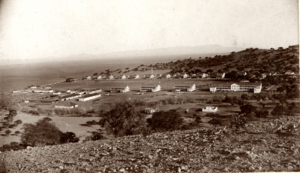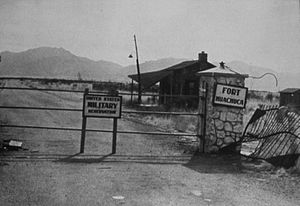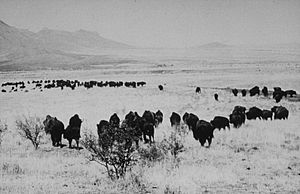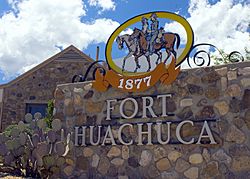Fort Huachuca facts for kids
Quick facts for kids Fort Huachuca |
|
|---|---|
| Cochise County, Arizona Near Sierra Vista, Arizona in United States |
|
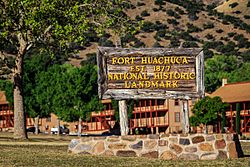 |
|
     
Insignia of units stationed at Fort Huachuca
Motto: "From sabres to satellites" |
|
|
Location in Arizona##Location in the United States
|
|
| Coordinates | 31°33′19″N 110°20′59″W / 31.555357°N 110.349754°W |
| Type | Army Post |
| Site information | |
| Owner | United States |
| Controlled by | |
| Open to the public |
Yes |
| Condition | Active |
| Site history | |
| Built | 3 March 1877 |
| In use | 143 years |
| Battles/wars | Apache Wars 1849–1924 Pancho Villa Expedition 1916–1917 |
| Garrison information | |
| Current commander |
|
| Garrison | USAG Fort Huachuca |
| Occupants |
|
Fort Huachuca is a special place where the United States Army trains soldiers and works on important projects. It was started a long time ago, on March 3, 1877, as Camp Huachuca. Today, it's managed by the United States Army Installation Management Command.
You can find Fort Huachuca in Cochise County, Arizona in the southeastern part of Arizona. It's about 15 miles (24 km) north of the Mexico–United States border and sits at the northern end of the Huachuca Mountains. The town of Sierra Vista, Arizona is right next to it.
For many years, from 1913 to 1933, Fort Huachuca was home to the "Buffalo Soldiers" of the 10th Cavalry Regiment. These were African American soldiers who played a big role in American history. During World War II, the fort grew very large, with space for over 25,000 soldiers. In 2010, about 6,500 active duty soldiers, 7,400 military family members, and 5,000 civilian employees lived there. On weekdays, more than 18,000 people are usually on the base.
Today, some of the main groups at Fort Huachuca include the Army Network Enterprise Technology Command (NETCOM) and the United States Army Intelligence Center. There's also an airfield called Libby Army Airfield, which shares its runway with the local Sierra Vista airport. Fort Huachuca was even considered as a backup landing spot for the Space Shuttle! It's also the main base for the Army's Military Auxiliary Radio System.
The fort has a special radar balloon called an aerostat that floats high in the sky. This helps with monitoring and security.
Contents
Exploring Fort Huachuca's Past
Fort Huachuca was first built to help protect the border with Mexico and deal with threats from the Chiricahua Apache people during the Apache Wars. On March 3, 1877, Captain Samuel Whitside chose this spot because it had hills for protection and a stream for water. In 1882, Camp Huachuca officially became Fort Huachuca.
In 1886, General Nelson A. Miles used Fort Huachuca as his main base during his campaign against Geronimo. After Geronimo surrendered, the Apache threat ended. However, the army kept the fort open because it was in a very important location near the border.
The Buffalo Soldiers' Home
In 1913, the fort became the home base for the "Buffalo Soldiers" of the 10th Cavalry Regiment. These brave African American soldiers were stationed there for twenty years. During General Pershing's mission in Mexico from 1916–1917, the fort was used to store supplies and equipment. From 1916 to 1917, Charles Young, the first African American to become a colonel, was in charge of the base. In 1933, the 25th Infantry Regiment took over from the 10th Cavalry.
Fort Huachuca During World War II
During the build-up for World War II, Fort Huachuca grew a lot. It covered a huge area of about 71,253 acres (288 km2) and could house over 25,000 soldiers. The 92nd and 93rd Infantry Divisions, which were made up of African-American troops, trained at Fort Huachuca.
Reopening and New Missions
In 1947, the fort was closed and given to the Arizona Game and Fish Department. But when the Korean War started, the base was reopened in 1951. The U.S. Air Force briefly took control, but the Army got it back a month later. They used it to train engineers to build airfields. The engineers built what is now Libby Army Airfield. After the Korean War, the fort was put on inactive status again in 1953.
Fort Huachuca was reactivated in 1954. This marked a new chapter, as the fort began to focus on electronic warfare. This means using electronic signals for military purposes, like gathering information or disrupting enemy communications. The Army's Electronic Proving Ground opened in 1954, and later, schools for electronic warfare and communications training were established.
In 1967, Fort Huachuca became the headquarters for the U.S. Army Strategic Communications Command. This command changed names over the years and is now known as NETCOM. NETCOM's job is to manage and protect the Army's computer networks and communications systems around the world.
Fort Huachuca was recognized as a National Historic Landmark in 1976. This was because of its important role in ending the Apache Wars and as the base for the Buffalo Soldiers. The fort also has a cemetery where about 3,800 veterans and their family members are buried.
In 1980, a special aviation unit, the 160th Special Operations Aviation Regiment (SOAR), trained at Fort Huachuca. They were preparing for a mission to rescue American personnel held captive in Iran. The desert mountains near the fort were perfect for practicing flying in conditions similar to Iran.
Discovering Fort Huachuca's Museums
Fort Huachuca has two museums where you can learn about its history and the Army's work.
Fort Huachuca Museum
The Fort Huachuca Museum is located in two buildings on the old part of the base. It tells the story of Fort Huachuca and the U.S. Army in the American Southwest. It especially highlights the Buffalo Soldiers and the Apache Wars. You can also find a gift shop there. Across the street, an annex building has outdoor displays, statues, and places to sit.
U.S. Army Intelligence Museum
The U.S. Army Intelligence Museum is inside the military intelligence (MI) Library. This museum shows off a collection of historical items related to military intelligence. You can see old spy radios, cameras used from planes, and even an Enigma machine, which was used to send secret codes during World War II. There are also two small drones and a piece of the Berlin Wall. The museum focuses on how Army intelligence has developed over time. There's a small gift shop with unique Fort Huachuca souvenirs.
Anyone can visit these museums for free! If you don't have a special military ID card, you'll need to pass a background check to enter the base. Visitors from other countries need to be with an active duty or retired military person.
What Happens at Fort Huachuca Today?
Fort Huachuca is a very important place for the Army's communications and intelligence work.
Signal and Communications Training
Fort Huachuca is home to NETCOM, which plans, builds, protects, and runs the Army's computer networks and communications systems. Their goal is to help commanders stay connected and in control during all military operations. The base used to be home to the 11th Signal Brigade, which helped provide communications during the 2003 invasion of Iraq. This unit later moved to Fort Hood, Texas.
The Army Electronic Proving Ground (USAEPG) at Fort Huachuca has been a leader in researching and developing new defense technology for many years. They test new communication devices and systems, like special radios that help soldiers communicate better in the field.
Military Intelligence Training
Besides the U.S. Army Intelligence Center, Fort Huachuca is also where the 111th Military Intelligence Brigade trains soldiers in military intelligence (MI). They teach courses for officers and warrant officers, covering topics like how to gather information from people (called Human Intelligence), how to analyze images (like from satellites), and how to understand electronic signals (called Electronic Intelligence).
The Army's MI branch used to be in charge of unmanned aerial vehicles (UAVs), also known as drones, until 2006. Now, the Aviation branch handles them. The 111th MI Brigade also runs the Joint Intelligence Combat Training Center at Fort Huachuca.
Learning at Fort Huachuca
Children living on the base attend schools run by the Fort Huachuca Accommodation Schools district. These include Colonel Johnston Elementary School (for grades K–2), General Myer Elementary School (for grades 3–5), and Colonel Smith Middle School (for grades 6–8). For high school, students go to Buena High School in Sierra Vista, Arizona.
Famous People Connected to Fort Huachuca
Many interesting people have served or lived at Fort Huachuca, including:
- Brigadier General Samuel Whitside, who founded the original camp.
- Major General Leonard Wood, a Medal of Honor winner and former Chief of Staff of the Army.
- Colonel Cornelius C. Smith, another Medal of Honor winner and a former commander of the fort.
- Bullet Rogan, a famous baseball player from the Negro league baseball.
- John Henry, who played professional baseball.
- General Alexander Patch, a decorated officer who led troops in World War II.
- Lieutenant General Sidney T. Weinstein, who helped reorganize Army intelligence.
- Specialist 5 Bobby Murcer, a Major League Baseball player for the New York Yankees.
- Luis Robles, a professional soccer goalkeeper, was born at Fort Huachuca.
- Jayne Cortez, a well-known poet, was born there.
Fort Huachuca in Movies and Books
Fort Huachuca has appeared in several movies and books:
- The movie Captain Newman, MD (1963), starring Gregory Peck, was filmed at the fort.
- Parts of Suppose They Gave a War and Nobody Came (1969) were also filmed there.
- In Clear and Present Danger (1994), starring Harrison Ford, equipment from Fort Huachuca is shown.
- Al Pacino's character in Scent of a Woman mentions being stationed at Fort Huachuca.
- The novel A Prayer For Owen Meany (1989) by John Irving features a character stationed at the fort.
- The memoir Going Back to Bisbee (1992) by Robert Shelton talks about his time at Fort Huachuca.
- A military reality TV series called Lone Target filmed an episode at the fort.
- Tumbleweed Forts (2021), a memoir by Frank Warner, describes exploring Fort Huachuca as a child when his father worked there on early drones. This book has also been adapted into a series for young readers.
Images for kids
-
Private William Major and Private Andrew Paxson on patrol of Fort Huachuca in 1942.
-
USAF Security Forces on a training exercise at Fort Huachuca.
-
American Boyd Melson (right), during the 2007 Military World Games, at which he won a gold medal at Fort Huachuca
See also
 In Spanish: Fuerte Huachuca para niños
In Spanish: Fuerte Huachuca para niños




